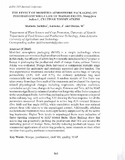The effect of modified atmosphere packaging on postharvest shelf life of mango fruits, mangifera indica l, cultivar tommy atkins

View/
Date
2011-09Author
Owino, W
Ambuko, J
Mutinda, Jackline
Language
enMetadata
Show full item recordAbstract
Modified atmosphere packaging (MAP) is a simple technology whose
optimization can minimize high postharvest losses in perishable commodities.
In this study, the efficacy of active bag® a recently introduced MAP product in
Kenya in prolonging the postharvest shelf of mango fruits, cultivar Tommy
Atkins was evaluated. Mango fruits harvested at commercial maturity stage
were selected for uniformity and randomly separated into five batches. The
five experimental treatments included three different active bags of varying
permeability (A35, A45 and A75), the ordinary polythene bag used
commercially and unpackaged control. A random sample of five fruits was
taken every three days from each of the treatments and evaluated for ripening
related physiological changes including respiration, ethylene evolution,
cumulative weight loss, changes in hue angle, firmness and "brix. All the MAP
treatments significantly enhanced postharvest longevity of the fruits compared
to the unpackaged fruits. Active bag packaging gave better response compared
to the ordinary bag, with active bag A35 showing the best response for all the
parameters measured. Fruits packaged in active bag A35 retained firmness
(five fold) and hue angle (60%), while cumulative weight loss was reduced
almost three fold relative to the unpackaged control. Additionally, ethylene
evolution and respiration rates were significantly suppressed by all the active
bag treatments. Higher "brix levels in unpackaged fruits were indicative of
faster ripening compared to MAP treated fruits. These findings show that
active bag can potentially prolong the postharvest shelf life and extend the
marketing period of mango fruits, thereby reducing postharvest losses. For
commercial application of active bag products, more research on their effect
on other fruit quality attributes is recommended.
Citation
Optimimization of Agricultural Value Chains for sustainable DevelopmentSponsorhip
National Council of Science and Technology, The Kenya Seed CompanyPublisher
Faculty of Agriculture, University of Nairobi
Description
Oral presentation at aGRO 2011 Biennial Conference
